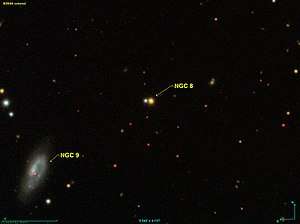NGC 8
NGC 8 is an asterism of two completely unrelated stars[1] (spectral types K6I and G4) in the constellation Pegasus, discovered on 29 September 1865 by Otto Wilhelm von Struve.[2] It is approximately 2.7 arc minutes away from NGC 9.[3]
| Observation data Epoch J2000 Equinox J2000 | |
|---|---|
| Constellation | Pegasus |
| Right ascension | 00h 08m 45.3s[1] |
| Declination | +23° 50′ 20″[1] |
| Other designations | |
The two stars are completely unrelated to each other, with the whiter, dimmer star being at a distance of 10400+4400
−2400 light years, and the yellower, brighter star having a minimum distance of 215,000 light years. While both stars are technically outside of the milky way's galactic disc, the nearer is 6400±2100 light-years south of the 1,000-light-year-thick disc, and the further is not only at least 130,000 light-years south of the disk, but is located entirely outside of the Milky Way itself, being at least 220,000 light-years from the galactic core.
References
- "NASA/IPAC Extragalactic Database". Results for NGC 0008.
- Steinicke, Wolfgang (2010). Observing and Cataloguing Nebulae and Star Clusters. Cambridge University Press. p. 283. ISBN 9780521192675.
- "NASA/IPAC Extragalactic Database". Notes for object NGC 0008. Retrieved 2010-05-09.
External links

- NGC 8 on WikiSky: DSS2, SDSS, GALEX, IRAS, Hydrogen α, X-Ray, Astrophoto, Sky Map, Articles and images
